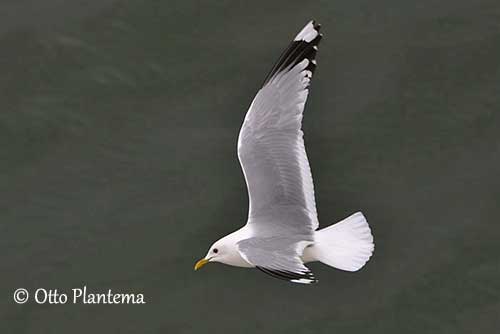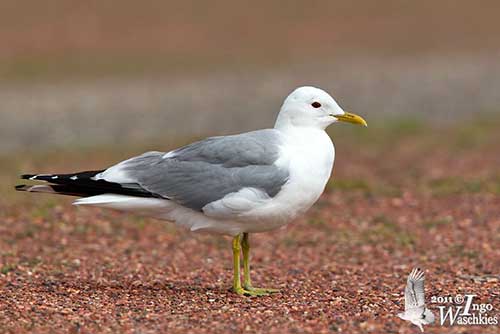
Fr: Goéland cendré
Ang: Mew Gull – Common Gull
All: Sturmmöwe
Esp: Gaviota cana
Ita: Gavina eurasiatica
Nd: Stormmeeuw
Sd: Fiskmås
Photographers:
John Anderson
John Anderson Photo Galleries
Steve Garvie
RAINBIRDER Photo galleries & Flickr Rainbirder
Tom Grey
Tom Grey's Bird Pictures & Tom Grey's Bird Pictures 2
Otto Plantema
Trips around the world
Ingo Waschkies
My bird pictures on Pbase
Text by Nicole Bouglouan
Sources:
HANDBOOK OF THE BIRDS OF THE WORLD Vol 3 by Josep del Hoyo-Andrew Elliott-Jordi Sargatal - Lynx Edicions - ISBN: 8487334202
THE HANDBOOK OF BIRD IDENTIFICATION FOR EUROPE AND THE WESTERN PALEARCTIC by Mark Beaman, Steve Madge - C. Helm - ISBN: 0713639601
THE COMPLETE BOOK OF BRITISH BIRDS – Written by “Royal Society for the Protection of Birds” experts - Préface de Magnus Magnusson - Michael Cady- Rob Hume Editors - ISBN: 0749509112
FIELD GUIDE TO THE BIRDS OF NORTH AMERICA - National Geographic Society - ISBN: 0792274512
L’ENCYCLOPEDIE MONDIALE DES OISEAUX - Dr Christopher M. Perrins - BORDAS - ISBN: 2040185607
Alaska Seabird Information Series – Mew Gull
All About Birds (Cornell Lab of Ornithology)
Animal Diversity Web (University of Michigan Museum of Zoology)
Bird Web (Seattle Audubon Society)
What Bird-The ultimate Bird Guide (Mitchell Waite)
Wikipedia, the free encyclopaedia
Mew Gull or Common Gull
Larus canus
Charadriiformes Order – Laridae Family
INTRODUCTION:
The Mew Gull is the name of the North American subspecies whereas Common Gull is that of European and Asian subspecies. They share a wide distribution in both New and Old Worlds. The race L.c. brachyrhynchus is sometimes considered a full species by some authors, but currently, four subspecies are recognized. However, more taxonomic studies are required.
The Mew Gull or Common Gull is the smallest “typical” gull with white head and black wingtips with white spots. It frequents the coastal waters during winter, but it breeds mainly around lakes, coastal marshes and moorland areas, sometimes away from water.
The Mew Gull or Common Gull breeds in northern temperate Eurasia and NW North America, and it winters along the seacoasts and around large lakes.
The species is currently not globally threatened, although the wide range does not allow the determination of the population trend.

DESCRIPTION OF THE BIRD:
Biometrics L.c. canus:
Length: 40-46 cm
Wingspan: 110-125 cm
Weight: 300-500 g
The adult of nominate race Larus canus canus is about 1,5 times larger than the Black-headed Gull (C. ridibundus), and much smaller than the Herring Gull (L. argentatus).
In breeding plumage, head, body and tail are pure white, whereas mantle and upperwing are pale grey. The upperwing shows a broad, white trailing edge. The tip of the wing is black with large white spots on outer two primaries. The underwing is white except the black wingtip.
Bill, legs and webbed feet are greenish-yellow. The eyes are dark brown with red eyering, although some individuals may have paler eyes.
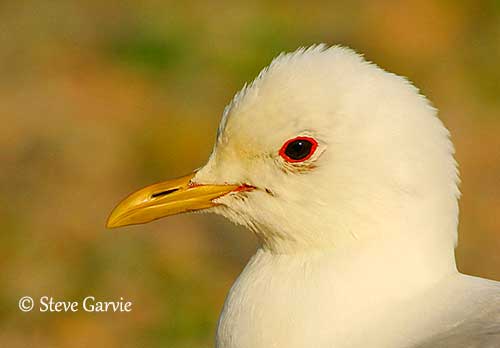
The Mew Gull in non-breeding plumage has duller bare parts, and the bill may sometimes show a narrow, dark bar at or near the tip. It has grey streaks on head and hindneck.
Male and female are similar.
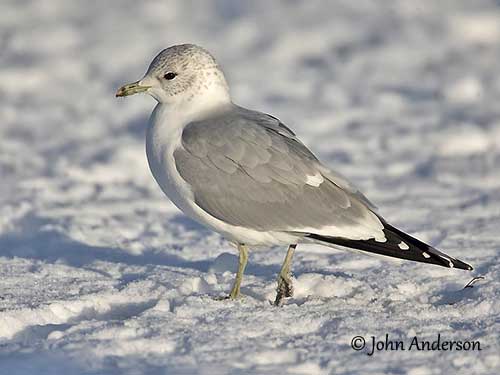
The juvenile is greyish-brown with buff mottling on head and breast. Mantle and scapulars are darker with pale-edged feathers. In flight, the outer primaries appear darker. There is a paler area on the inner primaries. The tail is white with black subterminal bar. The bill is blackish. Legs and feet are fleshy.
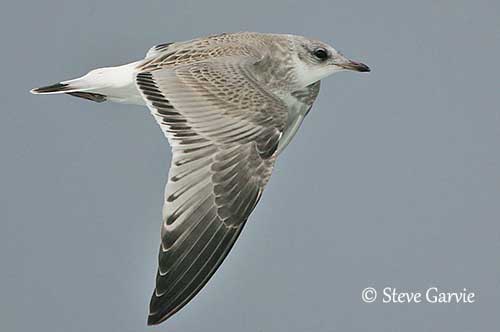
The first winter is paler below and has pale grey mantle. The two-tone bill has black tip and pale pinkish or greenish base. The underwing-coverts are pale and dark-tipped.
The second winter resembles adult, but it has smaller wing mirrors and dark primary coverts.
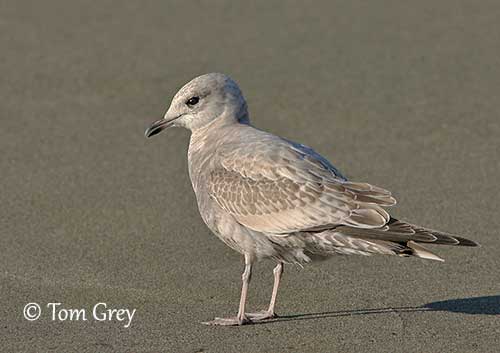
First winter
L.c. brachyrhynchus
SUBSPECIES AND RANGE:
The Mew Gull has four recognized subspecies.
L.c. canus or Common Gull breeds in Iceland and British Islands, E to White Sea. It winters from Europe to N Africa and Persian Gulf.
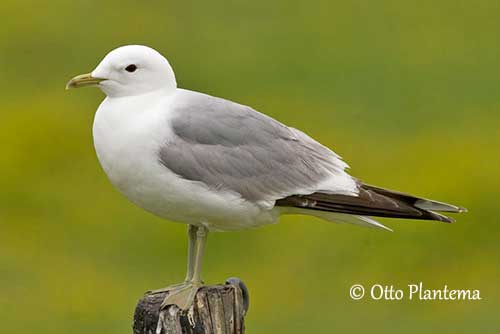
L.c. heinei or Russian Common Gull breeds in Russia from Kanin peninsula and Moscow Area, E to NC Siberia (R. Lena). It winters in SE Europe and at Black and Caspian Seas, and also in China and Japan.
This race is larger and darker, with heavier bill than nominate. Bill and legs are yellower. The bill show a dark subterminal bar all year round. Weight: 315-550 g.
L.c. kamtschatschensis or Kamchatka Gull breeds in NE Siberia and winters in Japan and E China.
This race is the largest. It is darker than nominate in all plumages, but the winter head pattern of adults is less pronounced than in Canus, and black is more extensive at wingtip. The eyes of the adults may be pale brown or dark. Weight: 394-586 g.
L.c. brachyrhynchus or Mew Gull or Short-billed Gull, breeds in N Alaska and N Mackenzie, S to S British Columbia and N Saskatchewan. It winters S to California.
This race is smaller than the Old World races. It has shorter bill too. The adults have less black on wingtips. Weight: 320-550 g. Wingspan: 96-102 cm. This one is sometimes considered a full species.
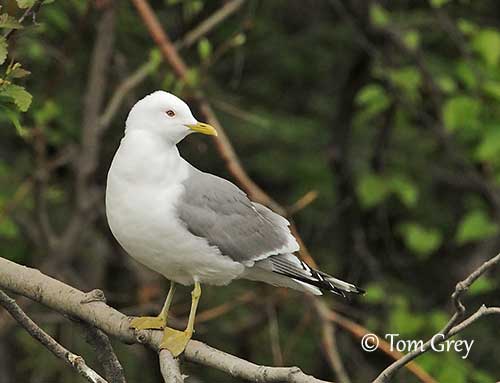
HABITAT:
The Mew Gull forms large flocks during winter in moorland areas and large lakes, estuaries, mudflats and harbours.
They forage along the shores, but they also feed inland, sometimes far from the sea. They can be seen in cultivated areas where they feed on invertebrates.
During summer, it breeds around lakes in northern forest, in tundra, marshy areas, rivers, ponds, islands and coastal cliffs.
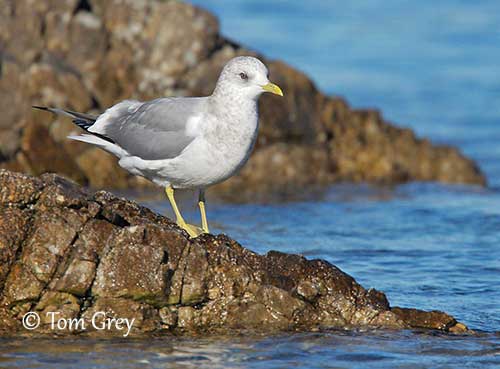
CALLS AND SONGS: SOUNDS BY XENO-CANTO
The Mew Gull utters a shrill, high-pitched, nasal “gleeoo” while the head is stretched up and back. This call is also given in flight. When it is threatened, it gives a similar, but shorter, repeated “gleeu-gleeu-gleeu…” and a frequent, short “keow”.
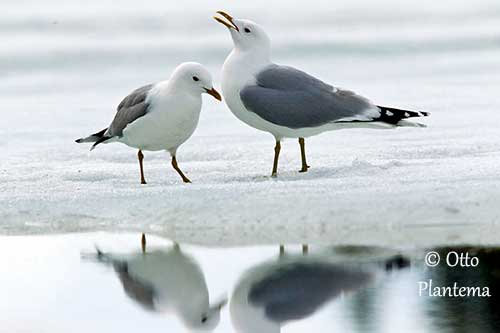
BEHAVIOUR IN THE WILD:
The Mew Gull feeds on small fish, aquatic and terrestrial invertebrates, insects and earthworms, depending on the location.
Along coasts, it feeds mainly on fish, crustaceans, molluscs and sea urchins. Around inland waters, it takes insects, earthworms, small rodents and young birds, but also carrion and refuse. Some grain is taken, and berries in late summer.
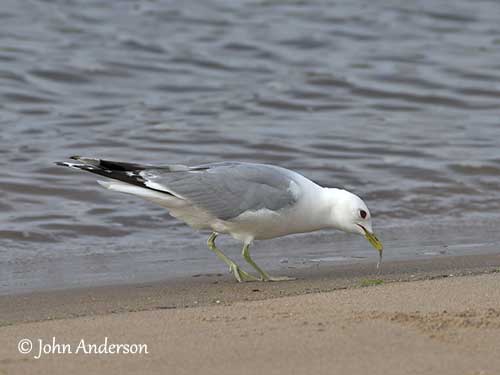
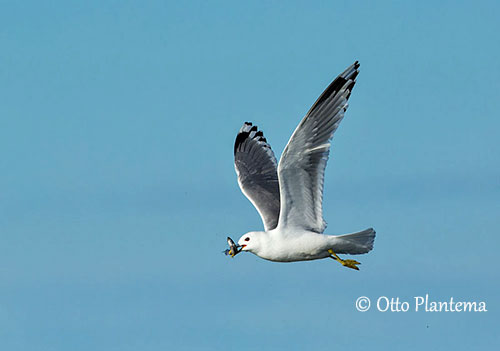
It forages by walking, wading and swimming. It also dips down to the water while fluttering over the surface. The preys with hard shells are dropped on rocks to break them open. It also catches flying insects in the air. Large groups may congregate at garbage dumps.
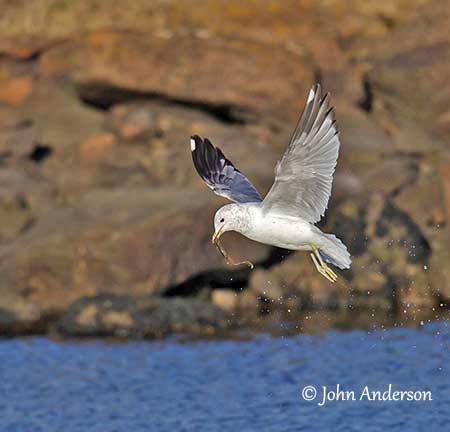
The Mew Gull performs the typical courtship displays of Laridae at the beginning of the breeding season. Usually, a female approaches a male holding a territory with a hunched posture, while the head is wagging from side to side. She begs for food to the male.
They often nest in colonies, on high ground near water, but also at bush top or in tree. However, they also may nest in isolated pairs. They are monogamous.
The adults are territorial and defend the nest aggressively by diving and swooping upon intruders.
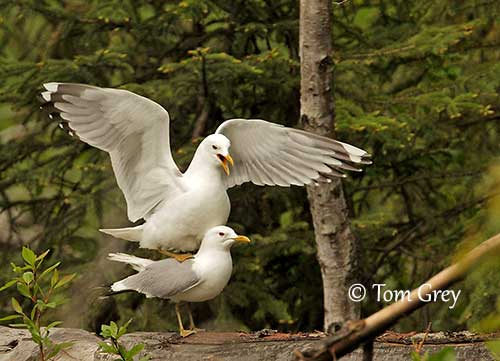
The Mew Gull is largely migratory, although the nominate race is the least migratory, only moving on short distances, whereas other individuals are sedentary.
They migrate in flocks and large roosts of several thousands of birds occur along the routes in autumn, especially in Denmark and The Netherlands.
The Mew Gull is a good flier and performs graceful, buoyant flight.
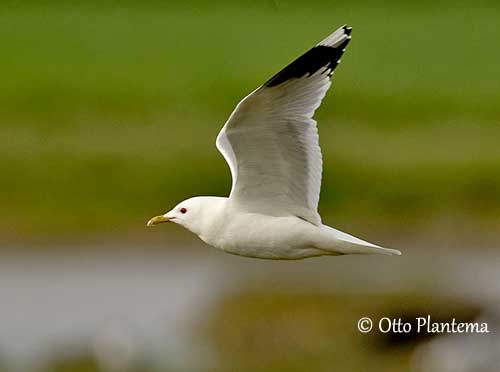
REPRODUCTION OF THIS SPECIES:
The Mew Gull usually breeds in small colonies, but numerous pairs often nest solitary. The laying occurs in May.
The nest site is placed on high ground near water, or at top of stump, on bare rock or even in trees (mainly conifers), and on islands in marshes among the vegetation.
The nest is mainly built by the female, but the male remains in the surrounding and may help sometimes. The nest is made with seaweeds, twigs, mosses, bark, grasses and stems, forming a shallow cup of vegetation. In tree, the nest is mostly a platform or a shallow cup of twigs and grasses.
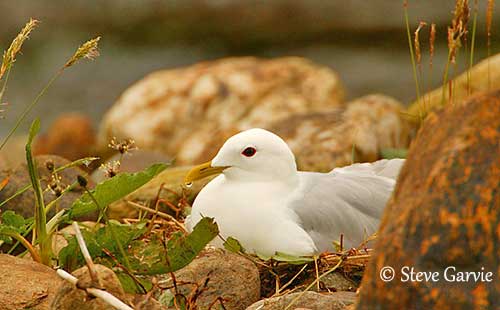
The female lays 1-3 pale brown/olive eggs with brown markings. Both adults incubate during 24-26 days. At hatching, the downy chicks are buff with dark spots above and pale underparts. Both parents tend and feed the chicks with insects and small fish. But at 20 days old, the young begin to forage on their own. They fledge about 30-35 days after hatching, and become independent a few days later.
The adults defend the nest and may perform distraction displays to drive the predators away from the nest site.
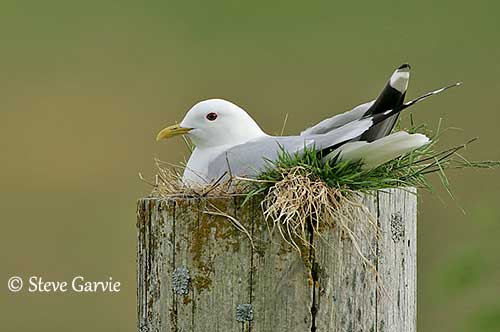
PROTECTION / THREATS / STATUS:
The Mew Gull is threatened on the breeding grounds by introduced ground predators such as the American mink (Neovison vison) and by human disturbance. Habitat loss through drainage, afforestation and various transformations is another threat for this species.
The global population was estimated to number 2,500,000/3,700,000 individuals in 2006. The race Canus is the most abundant with a population of 2,250,000 individuals. The race Heinei includes 1,000,000 birds. The race Brachyrhyncus has up to 360,000 individuals and the race Kamtschatschensis has only 100,000 individuals.
But currently, The Mew Gull or Common Gull is evaluated as least Concern.
